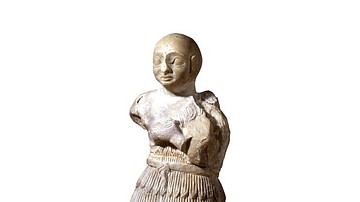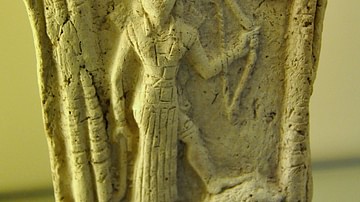Search
Search Results

Definition
Code of Ur-Nammu
The Code of Ur-Nammu (c. 2100-2050 BCE) is the oldest extant law code in the world. It was written by the Sumerian king Ur-Nammu (r. 2047-2030 BCE) or his son Shulgi of Ur (r. 2029-1982 BCE) centuries before the famous Code of Hammurabi was...

Definition
Early Dynastic Period (Mesopotamia)
The Early Dynastic Period of Mesopotamia is the modern-day archaeological term for the era in Mesopotamian history – 2900-2334 BCE – during which some of the most significant cultural advances were made including the rise of the cities, the...

Video
A Short History of Sumer and the Sumerian Civilization from Mesopotamia
The Sumerians flourished in Mesopotamia between c. 4100 – 1750 BCE in the region of Sumer which was not a country, but a region made up of a number of walled city-states, each with its own king. The Sumerian civilization developed the first...

Definition
Ishtar
Ishtar (Inanna in Sumerian sources) is a primary Mesopotamian goddess closely associated with love and war. This powerful Mesopotamian goddess is the first known deity for which we have written evidence. While largely unknown in the modern...

Article
Mesopotamian Education
Mesopotamian education was invented by the Sumerians following the creation of writing c. 3500 BCE. The earliest schools were attached to temples but later established in separate buildings in which the scribes of ancient Mesopotamia learned...

Image
Limestone Sumerian Plaque from Khafajah
This limestone plaque depicts two figures in relief. Cuneiform inscriptions appear at the upper part. It was excavated by the Oriental Institute of the University of Chicago in the early 1930s, 3rd season. The plaque dates back to the Early...

Video
Cuneiform Hand-Me-Downs - how Sumerian outlived its speakers
My favorite example of how odd Cuneiform became as it was passed from civilization to civilization. Thanks, rampant Sumerianization! Cuneiform languages took Sumerian very seriously, even after it was long dead. That’s how Akkadian and...

Definition
Cuneiform
Cuneiform is a system of writing first developed by the ancient Sumerians of Mesopotamia c. 3500 BCE. It is considered the most significant among the many cultural contributions of the Sumerians and the greatest among those of the Sumerian...

Article
Scribes in Ancient Mesopotamia
Scribes in ancient Mesopotamia were highly educated individuals trained in writing and reading on diverse subjects. Initially, their purpose was in recording financial transactions through trade, but in time, they were integral to every aspect...

Article
Lost Treasures From Iraq: Revisited & Identified
For how long do we build a household? For how long do we seal a document? For how long do brothers share the inheritance? For how long is there to be jealousy in the land(?)? The Epic of Gilgamesh, chapter 10, Tablet X. I have always...